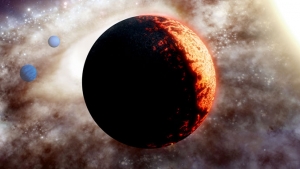Research out of the University of Hawaiʻi Institute for Astronomy (IfA) is the focus of an animated children’s educational YouTube video, but viewer beware, you may end with a really catchy tune stuck in your head.
In January, IfA astronomers announced that they discovered a rocky planet known as a “Super-Earth TOI 561b” using the W. M. Keck Observatory telescopes on Maunakea. The planet orbits the star TESS Object of Interest (TOI) 561, and has sparked interest around the world.
“Kids Learning Tube” recently posted a YouTube video explaining the Super-Earth TOI 561b and it received more than 100,000 views in less than a week. One of the scenes in the video shows a picture of the face of Lauren Weiss, the Beatrice Watson Parrent Postdoctoral Fellow at IfA and leader of the team that discovered the TOI-561 planetary system.

“It is an honor to have our work highlighted, though I was surprised to see my face,” said Weiss. “It’s educational and funny, and best of all, it exposes kids to science.”
- Related UH News story: Rocky planet discovered around one of the galaxy’s oldest stars, January 11, 2021
IfA astronomers discovered TOI 561b in the Milky Way galaxy. By measuring the wobble of the star induced by the planet’s gravity, they were able to infer that the planet has three times the mass of Earth.
“The rocky planet orbiting TOI-561 is one of the oldest rocky planets yet discovered. Its existence shows that the universe has been forming rocky planets almost since its inception 14 billion years ago,” said Weiss when the discovery was announced.
The discovery is an example of UH Mānoa’s goal of Excellence in Research: Advancing the Research and Creative Work Enterprise (PDF), one of four goals identified in the 2015–25 Strategic Plan (PDF), updated in December 2020.

